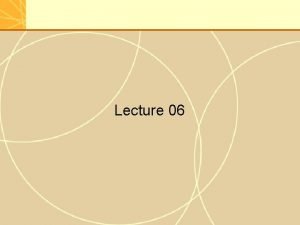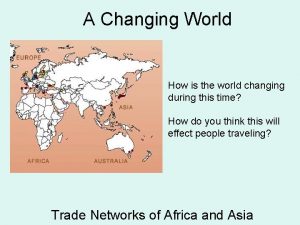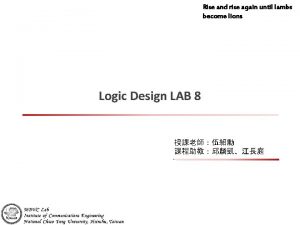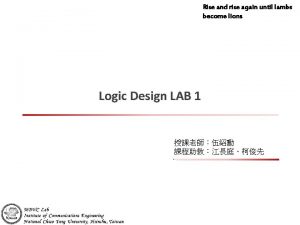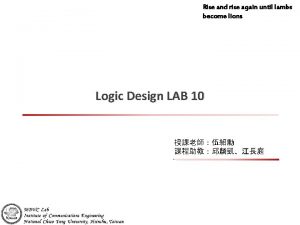A Changing World Again Until 1800 most people













- Slides: 13


A Changing World… Again! � Until 1800, most people lived on farms in the US and Western Europe. � Economy - based on: 1. Farming 2. Making goods by hand 3. Trading UNTIL…. The Industrial Revolution – machines replaced hand tools in the manufacturing of goods, people left their farms to work in factories… within 100 years, many nations became industrial giants Quick video! http: //www. youtube. com/watch? v=3 Efq-a. NBkvc

Where it started � 1780 s in Great Britain � Why there? � Britain had all the factors of production needed to shift from an agricultural to industrial society: 1. People to work 2. Natural resources – iron and coal (used to make machines and run steam engines) ** colonial empire to supply other needed materials – India provided raw cotton to supply textile mills 3. Money to invest in railroads and factories 4. Markets to sell manufactured goods 5. Transportation to and from factories. Video break! http: //www. youtube. com/watch? v=zh. L 5 DCizj 5 c

Cottage Industry System to Factory System Reminder Cottage Industry System: people worked in their own homes or workshops Factory System: The system of producing goods made on a mass scale by machines in a factory which replaced goods made by individual craftsmen.

Which picture shows the factory system? The cottage system? A B

EQ: In what ways did the factory system change the face of labor in England?

Industrial Cities ** London’s population grew from 1 million in 1800 to 2. 5 million in 1850…. WOW To accommodate these large populations, cheap housing was built and factories sprang up everywhere to employ workers for low wages and continue to increase production

Population Growth Between 1800 and 1850 – population of cities in Europe and the US grew very quickly… workers needed to live closer to factories and mills During this time, changes in farming meant that fewer workers were needed – available jobs caused displaced farmers to flock to Industrial cities (pull factor) Machines made production faster, so a large number of unskilled workers were needed to operate them

So. Many. People. Living conditions were terrible for workers They gathered in poor, crowded neighborhoods near their work called slums Tenements – 5 and 6 story wooded apartment buildings (usually with 2 rooms)

What it was like Problems: 1) poor design 2) landlord neglect 3) structure of old buildings 4) little government intervention These problems led to very hazardous living conditions in these tenements: Inadequate garbage pickup – tenants dumped their garbage into the shafts/alleys between apartments. little fresh air - the smell was horrendous - sewage would flow openly in gutters and threatened to spread diseases Diseases such as cholera and typhus were very common Cholera explained: http: //www. youtube. com/watch? v=c. GDEqc. J 1 sk. E&safe=active

The Working Class Although cities offered work, it paid poorly, was dangerous, and the days were long and hard Factories had: 1) Extreme temps 2) A lack of fresh air – dust often sickened workers 3) Dangerous working conditions Work was 12 -16 hours a day Women were paid 50% less than men

Working Conditions

The New Middle Class Middle class prior to IR – craftsman, merchants, shop owners, professionals (doctors, lawyers) The Industrial Revolution created new members of the middle class: 1) Men who provided $$ for new factories 2) Men who managed new businesses Families lived in working class neighborhoods in well-built homes (much nicer than slums) Women stayed home, managed children and servants, and took care of the home (they did not need to work in factories)
 Rise again and again until lambs
Rise again and again until lambs Rise and rise again
Rise and rise again Peace be with you till we meet again
Peace be with you till we meet again Rise and rise again until lambs become lions origin
Rise and rise again until lambs become lions origin Aha moment signpost
Aha moment signpost Song lyrics with alliteration
Song lyrics with alliteration What are the 6 signposts
What are the 6 signposts The changing world output and world trade picture
The changing world output and world trade picture The changing world output and world trade picture
The changing world output and world trade picture Who started herbalife
Who started herbalife World changing glasgow
World changing glasgow Unchanging values in a changing world pictures
Unchanging values in a changing world pictures Systems analysis and design in a changing world
Systems analysis and design in a changing world Systems analysis and design in a changing world
Systems analysis and design in a changing world








